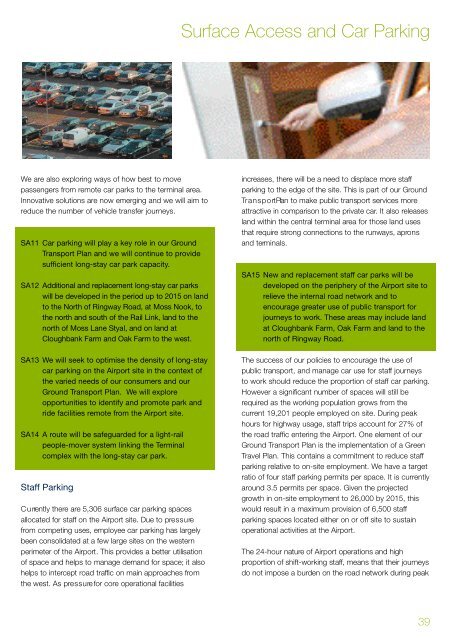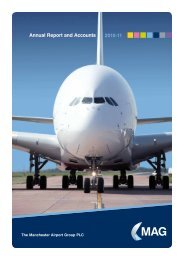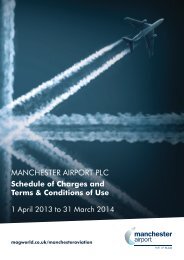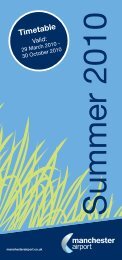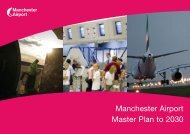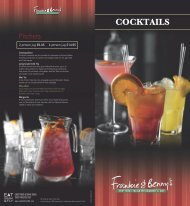Land use plan - Manchester Airport
Land use plan - Manchester Airport
Land use plan - Manchester Airport
You also want an ePaper? Increase the reach of your titles
YUMPU automatically turns print PDFs into web optimized ePapers that Google loves.
Surface Access and Car Parking<br />
We are also exploring ways of how best to move<br />
passengers from remote car parks to the terminal area.<br />
Innovative solutions are now emerging and we will aim to<br />
reduce the number of vehicle transfer journeys.<br />
SA11 Car parking will play a key role in our Ground<br />
Transport Plan and we will continue to provide<br />
sufficient long-stay car park capacity.<br />
SA12 Additional and replacement long-stay car parks<br />
will be developed in the period up to 2015 on land<br />
to the North of Ringway Road, at Moss Nook, to<br />
the north and south of the Rail Link, land to the<br />
north of Moss Lane Styal, and on land at<br />
Cloughbank Farm and Oak Farm to the west.<br />
SA13 We will seek to optimise the density of long-stay<br />
car parking on the <strong>Airport</strong> site in the context of<br />
the varied needs of our consumers and our<br />
Ground Transport Plan. We will explore<br />
opportunities to identify and promote park and<br />
ride facilities remote from the <strong>Airport</strong> site.<br />
SA14 A route will be safeguarded for a light-rail<br />
people-mover system linking the Terminal<br />
complex with the long-stay car park.<br />
Staff Parking<br />
C u rrently there are 5,306 surface car parking spaces<br />
allocated for staff on the <strong>Airport</strong> site. Due to pre s s u re<br />
f rom competing <strong>use</strong>s, employee car parking has larg e l y<br />
been consolidated at a few large sites on the western<br />
perimeter of the <strong>Airport</strong>. This provides a better utilisation<br />
of space and helps to manage demand for space; it also<br />
helps to intercept road traffic on main approaches fro m<br />
the west. As pre s s u re for core operational facilities<br />
i n c reases, there will be a need to displace more staff<br />
parking to the edge of the site. This is part of our Gro u n d<br />
Tr a n s p o rt Plan to make public transport services more<br />
attractive in comparison to the private car. It also re l e a s e s<br />
land within the central terminal area for those land <strong>use</strong>s<br />
that re q u i re strong connections to the runways, apro n s<br />
and term i n a l s .<br />
SA15 New and replacement staff car parks will be<br />
developed on the periphery of the <strong>Airport</strong> site to<br />
relieve the internal road network and to<br />
encourage greater <strong>use</strong> of public transport for<br />
journeys to work. These areas may include land<br />
at Cloughbank Farm, Oak Farm and land to the<br />
north of Ringway Road.<br />
The success of our policies to encourage the <strong>use</strong> of<br />
public transport, and manage car <strong>use</strong> for staff journeys<br />
to work should reduce the proportion of staff car parking.<br />
However a significant number of spaces will still be<br />
required as the working population grows from the<br />
current 19,201 people employed on site. During peak<br />
hours for highway usage, staff trips account for 27% of<br />
the road traffic entering the <strong>Airport</strong>. One element of our<br />
Ground Transport Plan is the implementation of a Green<br />
Travel Plan. This contains a commitment to reduce staff<br />
parking relative to on-site employment. We have a target<br />
ratio of four staff parking permits per space. It is currently<br />
around 3.5 permits per space. Given the projected<br />
growth in on-site employment to 26,000 by 2015, this<br />
would result in a maximum provision of 6,500 staff<br />
parking spaces located either on or off site to sustain<br />
operational activities at the <strong>Airport</strong>.<br />
The 24-hour nature of <strong>Airport</strong> operations and high<br />
p ro p o rtion of shift-working staff, means that their journ e y s<br />
do not impose a burden on the road network during peak<br />
39


